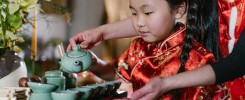As someone who has worked in the tea industry for over a decade, handling shipments from Yunnan to Assam and tasting teas from dozens of regions, I often get asked: “What exactly is the difference between Puerh tea and black tea?” At first glance, they might seem similar—they both brew into dark, flavorful cups—but their histories, production methods, and sensory experiences are fundamentally different. Let me walk you through what I’ve learned over years of wholesale trading and tasting.
Table of Contents
Origins and Plant Varieties
In my experience, understanding a tea starts with the plant and the region. Black tea, which is widely cultivated in China, India, Sri Lanka, and Kenya, usually comes from younger tea bushes grown on controlled plantations. Its flavor is largely consistent because the plants and terroir are carefully managed for yield and uniformity.
Puerh, on the other hand, comes almost exclusively from Yunnan province in China. I’ve personally visited tea gardens where some of the trees are hundreds of years old. These Da Ye (large-leaf) tea trees grow in subtropical mountains with rich soil and high humidity. The age and size of the leaves are key—they provide higher polyphenol content, which allows Puerh to ferment and age gracefully. From a professional standpoint, this is why Puerh is so different from any standard black tea.
Processing: Oxidation vs. Fermentation
Black tea is fully oxidized. From my perspective, its process is efficient: leaves are plucked, withered, rolled, oxidized, and then dried. This produces a bold, bright flavor, and the tea is ready to drink immediately. I often recommend black tea to clients who want a reliable, consistent product for everyday use.
Puerh, however, is a different story. There are two main types: Sheng (raw) and Shou (ripe). Sheng Puerh undergoes minimal processing and ferments slowly over years. Shou Puerh accelerates fermentation using a method called wo dui, producing dark, mellow flavors in months rather than decades.
Having handled both for wholesale distribution, I can tell you that this difference matters not just for flavor but also for market strategy. Black tea is a product that sells quickly and consistently. Puerh is more like a living asset—it can improve with age, sometimes becoming a rare and highly sought-after commodity.
Flavor Profiles and Brewing
I always tell my customers that black tea is straightforward. Assam is malty and strong; Darjeeling first flush is floral and brisk; Keemun has a subtle smokiness. Brewing is simple: 90–100°C (194–212°F) water for 3–5 minutes, and you’re done. I often describe it as reliable comfort in a cup.
Puerh, however, requires patience. Young Sheng Puerh can be brisk and slightly astringent, while aged Sheng develops smooth, complex notes—think earth, camphor, or dried fruit. Shou Puerh delivers deep, mellow flavors immediately. When I brew Puerh, I prefer multiple short infusions, allowing each cup to reveal new layers. It’s more than drinking—it’s a ritual, a practice that engages your senses and your attention.
Health Benefits
Over the years, I’ve seen customers choose teas not just for taste but for health. Black tea is rich in antioxidants like theaflavins and thearubigins, which support heart health and alertness. Its moderate caffeine gives a gentle boost.
Puerh offers something unique. The microbial fermentation introduces compounds that may aid digestion, regulate cholesterol, and support gut health. I’ve noticed that properly aged Puerh often tastes smoother and more balanced, and these chemical changes over time may enhance its health benefits. In my opinion, this is one of Puerh’s most fascinating aspects—it’s a tea that evolves in both flavor and potential wellness impact.
Aging, Storage, and Value
I always tell people that black tea is best consumed within a few years. Its flavor doesn’t improve with age—it only declines. Puerh is different. Sheng Puerh can age for decades if stored correctly: cool, dry, well-ventilated, and free from strong odors. Even Shou Puerh benefits from careful storage over several years.
From a wholesale perspective, this aging potential makes Puerh exciting. I’ve shipped young Sheng Puerh that, after a decade, has turned into a prized product with significantly higher value. Black tea rarely provides this investment dimension—it’s immediate, reliable, but fleeting in potential.
Final Thoughts
In my experience, black tea and Puerh serve different purposes. Black tea is bold, consistent, and versatile—a perfect everyday companion. Puerh is a journey. Its evolving flavor, health benefits, and aging potential reward patience and mindfulness.
For anyone exploring tea seriously, I recommend experiencing both. Understanding the production methods, plant origins, and brewing rituals deepens your appreciation and allows you to enjoy tea not just as a drink but as a cultural and sensory adventure. For me, Puerh represents the soul of tea—alive, evolving, and endlessly fascinating. Black tea represents its breadth—accessible, reliable, and universally loved. Together, they offer the full spectrum of what tea has to offer.

